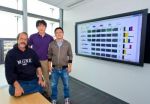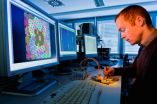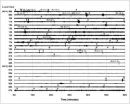(Press-News.org) Engineering faculty and students at the University of Colorado Boulder have produced the first experimental results showing that atomically thin graphene membranes with tiny pores can effectively and efficiently separate gas molecules through size-selective sieving.
The findings are a significant step toward the realization of more energy-efficient membranes for natural gas production and for reducing carbon dioxide emissions from power plant exhaust pipes.
Mechanical engineering professors Scott Bunch and John Pellegrino co-authored a paper in Nature Nanotechnology with graduate students Steven Koenig and Luda Wang detailing the experiments. The paper was published Oct. 7 in the journal's online edition.
The research team introduced nanoscale pores into graphene sheets through ultraviolet light-induced oxidative "etching," and then measured the permeability of various gases across the porous graphene membranes. Experiments were done with a range of gases including hydrogen, carbon dioxide, argon, nitrogen, methane and sulphur hexaflouride -- which range in size from 0.29 to 0.49 nanometers -- to demonstrate the potential for separation based on molecular size. One nanometer is one billionth of a meter.
"These atomically thin, porous graphene membranes represent a new class of ideal molecular sieves, where gas transport occurs through pores which have a thickness and diameter on the atomic scale," said Bunch.
Graphene, a single layer of graphite, represents the first truly two-dimensional atomic crystal. It consists of a single layer of carbon atoms chemically bonded in a hexagonal "chicken wire" lattice -- a unique atomic structure that gives it remarkable electrical, mechanical and thermal properties.
"The mechanical properties of this wonder material fascinate our group the most," Bunch said. "It is the thinnest and strongest material in the world, as well as being impermeable to all standard gases."
Those characteristics make graphene an ideal material for creating a separation membrane because it is durable and yet doesn't require a lot of energy to push molecules through it, he said.
Other technical challenges will need to be overcome before the technology can be fully realized. For example, creating large enough sheets of graphene to perform separations on an industrial scale, and developing a process for producing precisely defined nanopores of the required sizes are areas that need further development. The CU-Boulder experiments were done on a relatively small scale.
The importance of graphene in the scientific world was illustrated by the 2010 Nobel Prize in physics that honored two scientists at Manchester University in England, Andre K. Geim and Konstantin Novoselov, for producing, isolating, identifying and characterizing graphene. Scientists see a myriad of potential for graphene as research progresses, from making new and better display screens and electric circuits to producing tiny biomedical devices.
###
The research was sponsored by the National Science Foundation; the Membrane Science, Engineering and Technology Center at CU-Boulder; and the DARPA Center on Nanoscale Science and Technology for Integrated Micro/Nano Electromechanical Transducers at CU-Boulder.
Contact:
Scott Bunch, 303-492-6802
joseph.bunch@colorado.edu
Carol Rowe, 303-492-7426
carol.rowe@colorado.edu
Graphene membranes may lead to enhanced natural gas production, less CO2 pollution says CU study
2012-10-09
ELSE PRESS RELEASES FROM THIS DATE:
Fast walking and jogging halve development of heart disease and stroke risk factors
2012-10-09
The findings indicate that it is the intensity, rather than the duration, of exercise that counts in combating the impact of metabolic syndrome - a combination of factors, including midriff bulge, high blood pressure, insulin resistance, higher than normal levels of blood glucose and abnormal blood fat levels - say the authors.
Genes, diet, and lack of exercise are thought to be implicated in the development of the syndrome, which is conducive to inflammation and blood thickening.
The authors base their findings on more than 10,000 Danish adults, between the ages of ...
MRSA researchers identify new class of drug effective against superbug
2012-10-09
COLUMBUS, Ohio - In two separate studies, researchers at The Ohio State University Wexner Medical Center have discovered a new class of treatment against methicillin-resistant Staphylococcus aureus (MRSA) as well as evidence of a growing need to quickly genotype individual strains of the organism most commonly referred to as the "superbug."
"The public is most familiar with the dramatic progression of skin infections caused by MRSA, but MRSA is responsible for a range of difficult to treat illnesses," noted Dr. Kurt B. Stevenson, an infectious disease expert at Ohio ...
Young people need financial support and guidance when they age out of foster care, MU expert says
2012-10-09
COLUMBIA, Mo. – As the economy and job market continue to recover, many young adults have moved in with their parents to save money. For teens and 20-somethings who grew up in foster care, saving money is especially difficult because they have aged out of a system that provided support in earlier years and lack important family ties they can depend upon, particularly as they enter adulthood and embark on their own. Now, a University of Missouri child welfare expert says youths in foster care need financial education and support to build assets so they can become financially ...
A welcome predictability
2012-10-09
Synthetic biology is the latest and most advanced phase of genetic engineering, holding great promise for helping to solve some of the world's most intractable problems, including the sustainable production of energy fuels and critical medical drugs, and the safe removal of toxic and radioactive waste from the environment. However, for synthetic biology to reach its promise, the design and construction of biological systems must be as predictable as the assembly of computer hardware.
An important step towards attaining a higher degree of predictability in synthetic biology ...
Wireless data at top speed
2012-10-09
Whether it's a wedding, birthday party or other celebration, these days the chances are you'll have your camcorder with you to record the great occasion. But we often forget to bring the data cable along with us, so despite promising the hosts to transfer the images to their computer the morning after, we hardly ever do. "No problem," we say, "I'll burn you a CD when I get home." It would be so much easier, though, to transfer the data wirelessly.
This thought also occurred to Frank Deicke, a researcher at the Fraunhofer Institute for Photonic Microsystems IPMS in Dresden. ...
App protects Facebook users from hackers
2012-10-09
RIVERSIDE, Calif. (www.ucr.edu) — Cyber-crime is expanding to the fertile grounds of social networks and University of California, Riverside engineers are fighting it.
A recent four-month experiment conducted by several UC Riverside engineering professors and graduate students found that the application they created to detect spam and malware posts on Facebook users' walls was highly accurate, fast and efficient.
The researchers also introduced the new term "socware" to describe a combination of "social malware," encompassing all criminal and parasitic behavior on online ...
Fossil of ancient spider attack only 1 of its type ever discovered
2012-10-09
CORVALLIS, Ore. – Researchers have found what they say is the only fossil ever discovered of a spider attack on prey caught in its web – a 100 million-year-old snapshot of an engagement frozen in time.
The extraordinarily rare fossils are in a piece of amber that preserved this event in remarkable detail, an action that took place in the Hukawng Valley of Myanmar in the Early Cretaceous between 97-110 million years ago, almost certainly with dinosaurs wandering nearby.
Aside from showing the first and only fossil evidence of a spider attacking prey in its web, the piece ...
Poorer lung health leads to age-related changes in brain function
2012-10-09
COLUMBUS, Ohio – Keeping the lungs healthy could be an important way to retain thinking functions that relate to problem-solving and processing speed in one's later years, new research suggests.
While these two types of "fluid" cognitive functions were influenced by reduced pulmonary function, a drop in lung health did not appear to impair memory or lead to any significant loss of stored knowledge, the study showed.
Researchers used data from a Swedish study of aging that tracked participants' health measures for almost two decades. An analysis of the data with statistical ...
Computational model IDs potential pathways to improve plant oil production
2012-10-09
UPTON, NY - Using a computational model they designed to incorporate detailed information about plants' interconnected metabolic processes, scientists at the U.S. Department of Energy's Brookhaven National Laboratory have identified key pathways that appear to "favor" the production of either oils or proteins. The research, now published online in Plant Physiology, may point the way to new strategies to tip the balance and increase plant oil production.
The study focused on the metabolism of rapeseed, a crop grown primarily in temperate climates for the oil that accumulates ...
2010 Korea bomb 'tests' probably false alarms, says study
2012-10-09
This spring, a Swedish scientist sparked international concern with a journal article saying that radioactive particles detected in 2010 showed North Korea had set off at least two small nuclear blasts--possibly in experiments designed to boost the yields of much larger bombs. Shortly after, the pot was stirred with separate claims that some intelligence agencies suspected the detonations were done in cooperation with Iran. Now, a new paper says the tests likely never took place—or that if they did, they were too tiny to have any military significance. The new report, ...



